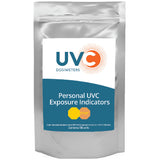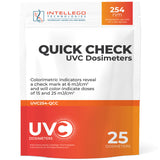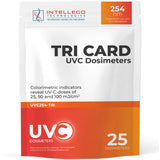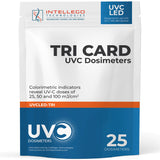How to Calculate UV-C Dose on a Surface
Posted by Dave on for ProLampSales

When UV-C fixtures or handheld devices are used to sanitize surfaces and objects, it may be useful to determine the UV dose applied and comparing that to tables of dose requirements for deactivating microorganisms.
Measure UV Intensity
To get accurate dose data you need to start with a UV-C detector. The detector needs to display an intensity reading measured in microwatts per square centimeter (μW/cm² ). The Zenith detector is one example of a UV-C detector that will work well for this purpose.
With the UV-C fixture or handheld device turned on, the detector should be placed as close as possible to the same distance away from the UV-C source (lamp) as when it is being used to sanitize surfaces or objects. The meter will display the UV intensity in μW/cm².
Calculate UV Dose
UV Dose = UV Intensity (μW/cm² ) x Exposure Time (seconds)
Exposure time is how long the UV light is ON and delivering UV to a surface. Start with 20 or 30 seconds.
The result of this calculation will be a value expressed in μWSec/cm².
Compare Dose Calculation to Dose Required to Disable Various Pathogens
This value can be compared to the table below for various microorganisms. To deactivate any of these organisms, the value should match or exceed the dose values shown. You can simply change the Exposure Time until you reach the dose value you need.

- Posted in Ultraviolet Light
Featured Products (View All)
15 comments





I have a germicidal uvc handheld device with 2 x phillips mercury vapour globes. What microwatt at 6 inches would this put out please? It is to sanitize surfaces.
If we have 2 lump of 8W of length one feet. How we calculate time and range of disinfecting. Mean How long time interval and how much distance it disinfect
@Mark, could you tell me how you come up with the formulas?
@Carmelo
What are your bulbs rated for? Check your bulb spec sheet. It should show a value for Radiated Power. That is the ‘real’ wattage you should be using in your calculations.
How about Distance? If I have a 4 footer dual tube 30W UVC bulb on a 80 feet ceiling, how long will it need to be on? And how long would it cover?
@Mark
Thank you so much for these formulas! Your calculations work out but I do have one question.
My bulbs are rated at 18 watts. 18/ (2 π×2.54×102) This returns a value of 0.01105754583. In your example of .9 watts at 2.54cm. .9/ (2 π×2.54×8.5) returns a value of 0.0066345275.
Your final answer is 6.64 mW/cm2. Why are we using the 5th place value? Thanks for any advice.
Sorry had few missing words from my final example… so this is a correction to my last post….
Please see below the Irradiance formulas for any distance:
A) For a large distance to the lamp we get:
The irradiance = (Total Radiation flux (W)/ π2.a2 ——- For (a >> L)
B) At shorter distances the irradiance:
The irradiance = (Total Radiation flux (W)/ 2 π.a.L ——- For (a < 0.5 L)
Where total Radiation flux for 4W bulb is 0.9 w as you indicated
L: is arc length of the lamb which is distance between 2 arcs inside lamb tube which is 3.35” (85mm) for 4 Watt lamb
a: Is the perpendicular distance between surface & Bulb
If we assume distance is 1 meter as you stated then if you run through the calculation using A) formula >>>>> the irradiance would equal to 9.13 uW/cm2
If you want to calculate irradiance at 1 inch (2.54cm) then use formula B (since distance is smaller than half of the bulb length) >>>>> the irradiance would equal to 6.64 mW/cm2
Finally for distance of 4” (10.16cm) >>>>> the irradiance would equal to 884 uW/cm2
Using above 2 equations you could calculate irradiance at any distance.
Don’t forget these bibs operate at 254nm wavelength, and peak germicidal effect occurs at 260 to 264nm so you need to correct for the radiation generated by your bulb at 254 nm, which is approximately at 85% of the maximum germicidal effect. So derate you’re calculated irradiance by 15%. Hope this helps.
Mark Qandil
Here are the requested formulas for Irradiance at any desired length….
A) For a large distance to the lamp we get:
The irradiance = (Total Radiation flux (W)/ π2.a2 ——- For (a >> L)
B) At shorter distances the irradiance:
The irradiance = (Total Radiation flux (W)/ 2 π.a.L ——- For (a < 0.5 L)
Where total Radiation flux for 4W bulb is 0.9 w as you indicated
L: is arc length of the lamb which is distance between 2 arcs inside lamb tube which is 3.35” (85mm) for 4 Watt lamb
a: Is the perpendicular distance between surface & Bulb
If we assume distance is 1 meter as you stated then if you run through the calculation using A) formula >>>>> the irradiance would equal to 9.13 uW/cm2
If you want to calculate irradiance at 1 inch then use formula B (since distance is smaller than half of the bulb length) >>>>> the irradiance would equal to 6.64 mW/cm2
Finally >>>>> the irradiance would equal to 884 uW/cm2
Using above 2 equations you could calculate irradiance at any distance.
Don’t forget these bibs operate at 254nm wavelength, and peak germicidal effect occurs at 260 to 264nm so you need to correct for the radiation generated by your bulb at 254 nm, which is approximately at 85% of the maximum germicidal effect. So derate you’re calculated irradiance by 15%. Hope this helps.
Mark Qandil
how to calculate the irradiation of the 4W tube at 1cm, 2cm, 3cm and 4cm. As the company datasheet shown the output 0.9 W at 1meter. And company site shows the calculation of irradiation is inversely propotional to square of distance.
Greetings, I have been trying to figure this out for a while. These guys are the ones who we need to get in touch with somehow. They answer alot of these questions. https://www.researchgate.net/post/How_can_we_calculate_UV_light_intensity
AndrewB is correct. There is electric efficiency loss in the bulb. 60% is a good number.But that still leaves us with questions. I don’t know if Pi is what we should be using for the surface area. My bulbs are linear. Surface area of the bulb is also in the calculation. This is requiring waaay more math than I was programmed for.
These guys pulled 882μW/cm with an 11w wand. That means it would take almost 19 minutes to get to 1 Joule.
https://www.youtube.com/watch?v=FvL6DzwrF_g
There has to be a simpler way to figure this out. So if I have 2×55w instead of their 2×11w could I simply multiply those numbers to get the answer I’m looking for? I just can’t see spending big loot on a meter for just a few measurements. Any help would be great. Thanks fellas.
hello …i have one question…what is this? “(4 * pi * UV_bulb_distance^2)”….. circle area? the correct is => “circle area = pi*R^2”
Russell, the typical electric lamp efficiency is I believe 60%. So take 60% of the lamp’s W rating.
Thanks for EV dosage formula. Could you explain how to calculate Exposure time and also explain EV dosage with Example.
when a uw/cm2 is given in the spec sheet of a UV lamp say 2000 given for many hand held wand,
at what distance is it quoted ie 2000 at 1 m or what does that figure mean
can you please throw some light
Thanks
Thank you very much for your dosage chart. It is very useful. I am trying to fully understand the dosage chart based on μWs/cm2 because I have been using a formula to determine dosage and exposure time. The formula as follows.
UV_dose= UV_bulb_power * Exposure_time / (4 * pi * UV_bulb_distance^2)
My issue is understanding the result against your dosage chart of μWs/cm2.
What multiple do I need to add to my formula to compare equivalent results if any?
I would really appreciate if you would shed some ’’light’’ on this.
Best,
Russell